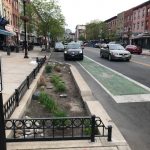New Jersey Future Blog
NJ Still Has Room to Grow. But Where…and How?
November 20th, 2007 by Jay Corbalis
A recent study commissioned by the Council on Affordable Housing found that:
- Of New Jersey’s 4.98 million acres, 1.24 million (25 percent) are vacant and unconstrained.
- These vacant acres have the capacity for 1,169,697 residential housing units and 1.63 billion square feet of non-residential space.
- Redevelopment of older housing and former commercial and industrial sites will produce an average of 8,251 additional residential units annually.
There is sufficient development capacity in the state to support projected growth well beyond 2018.
The Story Behind the Numbers
While the conclusions of the study show the state has sufficient capacity to meet its mid-term housing needs, those numbers don’t tell the whole story.
Only 39 percent of the vacant and unconstrained land identified in the study is located in the state’s “growth areas,” but this land is expected to account for 79.3 percent of the state’s residential growth. Nearly half (47 percent) of new residential units are projected to be built in Planning Area 2 (Suburban), designated centers and sewer service areas.
This is good news; it means growth will be occurring in areas the State Development and Redevelopment Plan deems suitable. What the study does not address however, is how that growth will occur. To accommodate the future growth the study projects, major changes will need to occur in the state’s urban and suburban areas.
The problem is this: The study calculated capacity using existing densities, not actual zoning. While the authors assume that a national trend toward more dense development will extend to New Jersey, the opposite may, in fact, be true. Between 1986 and 2002, while the state’s population increased by 12 percent, the amount of developed land increased by 21 percent. This suggests that new development in New Jersey is occurring at densities significantly lower than previously existing development in the state.
Today, zoning in many of these locations allows only for single-use, low-density development—in other words, sprawl. Many municipalities resist higher densities, fearful of increased congestion and school costs they could bring. Two programs have been launched recently in Massachusetts and Connecticut to address these concerns. These programs provide financial incentives to municipalities for zoning for higher-density, smart-growth housing. In Massachusetts, the program will also reimburse towns for additional school costs incurred from these units. If New Jersey municipalities are going to be expected to absorb so much future growth, the state will need to find a way to address their fears of higher-density zoning.
Redevelopment: Have Your Cake and Eat It Too
Redevelopment is also an important component of the state’s future growth potential. The study, based on historical trends, estimates that 8,251 residential units will be produced annually through redevelopment. But this doesn’t begin to get at the state’s redevelopment potential. Vacant homes and apartments, abandoned commercial strips, underutilized parking lots and empty factories, which can be found in abundance across the state, provide great opportunities for redevelopment—if the state were to make a concerted effort to promote it.
This type of growth makes sense for New Jersey. It allows the state to grow without losing open space—a win-win situation. Rather than building on farmland far away from employment centers, redevelopment would place housing where it makes the most sense: near jobs, transit and infrastructure. But for more redevelopment to occur, changes are needed. Targeted infrastructure investments by the state in urban areas would help cities prepare for new growth, as well as show the state’s commitment to redevelopment. More money and a streamlined process for brownfields cleanups would also help, as many vacant sites in urban areas are contaminated and require remediation.
Overall, the outlook for the state’s growth capacity is positive. We must be careful, however, not to let these vacant lands “burn a whole in our pocket.” Smart-growth planning and targeted redevelopment are essential if we are to avoid the mistakes of the past and develop in a way that preserves open space while creating vibrant communities.
If you have any questions about this issue of Future Facts, please contact Jay Corbalis, Policy Analyst.
















